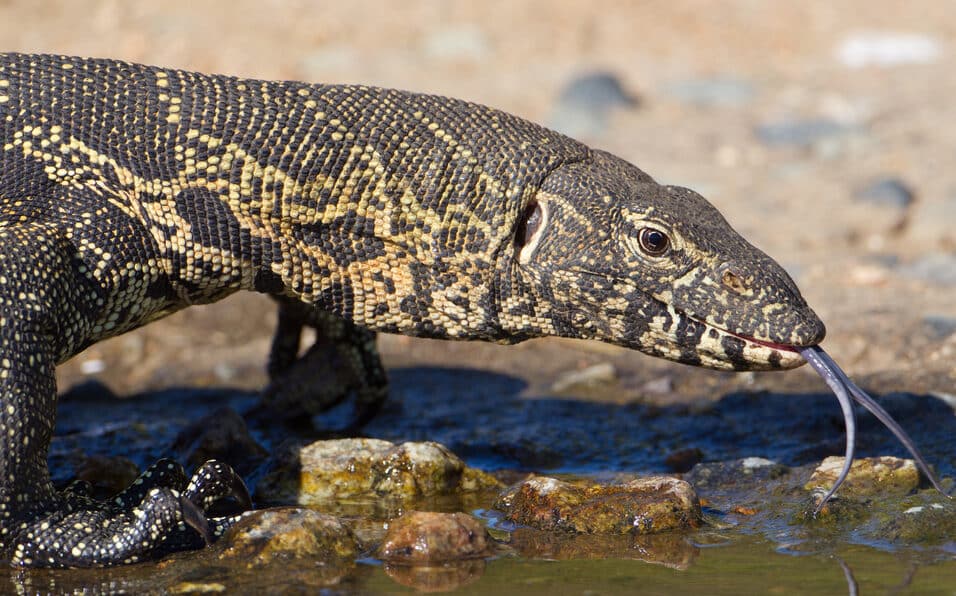5 Common LIZARDS found in Libya! (ID GUIDE)
Do you want to learn about the different kinds of lizards in Libya?

If so, you’ve come to the right place! In the article below, I have listed the lizards you can expect to see. For each species, you’ll find out how to identify that lizard correctly, along with pictures and interesting facts!
5 Lizards That Live IN Libya:
#1. African Chameleon
- Chamaeleo africanus

How to identify:
- Length: Up to 18 in (46 cm).
- Lifespan: Between 2 and 10 Years.
- The African Chameleon is mostly green and covered with black spots but can change color like most Chameleons.
The African Chameleon, also called “Sahel Chameleon,” is named after Sahel, a region between the Sahara and the Sudanian savanna. These lizards prefer to hide in reeds and shrubs in Libya and are often seen on low branches of trees.
With its four-toed feet and prehensile tail, the African Chameleon slowly moves through the branches until it finds its next meal, consisting mainly of insects that it catches with its sticky tongue.
The male roams the lower branches of trees during the breeding season to find a suitable female to mate with. After mating, the female leaves the security of the tree and goes down to the ground to dig a hole to lay her eggs in. The female lays up to 70 eggs, taking about three months before the youngsters appear.
#2. Bosc’s Fringe-toed Lizard
- Acanthodactylus boskianus

How to identify:
- They have five dark longitudinal stripes, and the middle stripe subdivides at the neck with an olive-grey dorsal.
- The males are larger than females. The female’s tail underside becomes red through the breeding period.
Bosc’s Fringe-toed Lizards are extremely active hunters in Libya and mainly feed on insects.
When the breeding season arrives, the males set out to secure a female, and she is very particular with whom she mates. Chemicals exude from femoral glands and play a role in sex recognition, courtship, and communication. Males with larger heads are the thing that makes a Bosc’s Fringe-toed Lizard female’s heartbeat faster.
Once the male secures a female, he is extremely territorial and will often discourage other males through aggression.
#3. Common Wall Gecko (Moorish Gecko)
- Tarentola mauritanica

- Adults grow up to 15 cm (6 in) long.
- They have spiny skin and variable coloring, which allows them to blend in with rocky terrain.
- Their shape is typical of a gecko, with a large head, thin abdomen, and prominent, large toes.
Common Wall Geckos are frequently spotted lizards in Libya.
These nocturnal lizards are known to be comfortable around people, and can easily scale the walls of your home, thus their common name. However, don’t be frightened if you see one inside! It won’t do you any harm, and it may eat a few pesky insects for you.
Common Wall Geckos, which are also called Moorish Geckos, have been introduced to many parts of the world via exotic plant shipments and the pet trade. While they don’t usually do serious damage as an invasive species, they can impact some plant life with their appetite.
#4. Common Chameleon
- Chamaeleo chamaeleon

Identifying Characteristics:
- Adults are 20-40 cm (8-16 in) long.
- Colors vary from yellow/brown to dark brown, with two light-colored lines along their sides.
- Females are significantly larger than males.
The Common Chameleon is one of the most well-known lizards in Libya!
Their camouflaging ability is well-known, as is the incredible length of their tongues. One lesser-known talent is the speed with which it catches its prey. The Common Chameleon uses its tongue to rapidly extend and catch insects on the sticky end.
Despite its quick tongue, the Common Chameleon is one of the slowest lizard species in the world. They must capitalize on their camouflage skills to avoid predators and catch prey.
One of the ways it goes undetected is to remain incredibly still for long periods. The Common Chameleon has two or three toes on each foot to help it balance, climb, and hold on to branches. To improve its stability, this reptile also uses its prehensile tail to improve its balance.
#5. Mediterranean House Gecko
- Hemidactylus turcicus

Identifying Characteristics:
- Adults are 3.8-6.3 cm (1.5-2.5 in) long.
- The pupils are vertical, and the eyes are large and round with immovable eyelids.
- This species has two color phases for camouflage.
- Pale phase: the coloring is light pink to pale yellow or white with brown or gray blotches.
- Dark phase: the coloring darkens to gray or brown, obscuring the blotches on the back.
This lizard is found around people in Libya.
Mediterranean House Geckos are nocturnal, but this won’t stop you from being able to find them. They’re considered an “urbanized” species, which means they’re just as happy to live inside your house as they are in the wild!

They eat insects attracted to lights and are commonly found on walls, ceilings, and window screens in homes. Outside, look for them in rock crevices or cracked tree trunks.
In addition to being comfortable around humans, Mediterranean House Geckos are a vocal species. The mating call of males is a series of clicks, and they make a squeaking noise if threatened.
Do you want to learn MORE about animals in Libya?
Check out these ID Guides!
-
Amazing ANIMALS to see in Libya! (ID guide w/ pics)
-
8 Common SPIDERS Found in Libya! (w/Pics)
-
4 Common SNAKES That Live in Libya! (ID Guide)
Which of these lizards in Libya is your favorite?
Leave a comment below!



